Ever wonder which Missouri lakes have the most snakes slithering through the area? Knowing where you’re likely to encounter snakes makes your day go more smoothly — whether you love or hate the legless reptiles.
The ecosystem surrounding lakes is terrific for snakes — there are plenty of places to hide and lots of food. Let’s discover which lakes in Missouri have the most snakes!
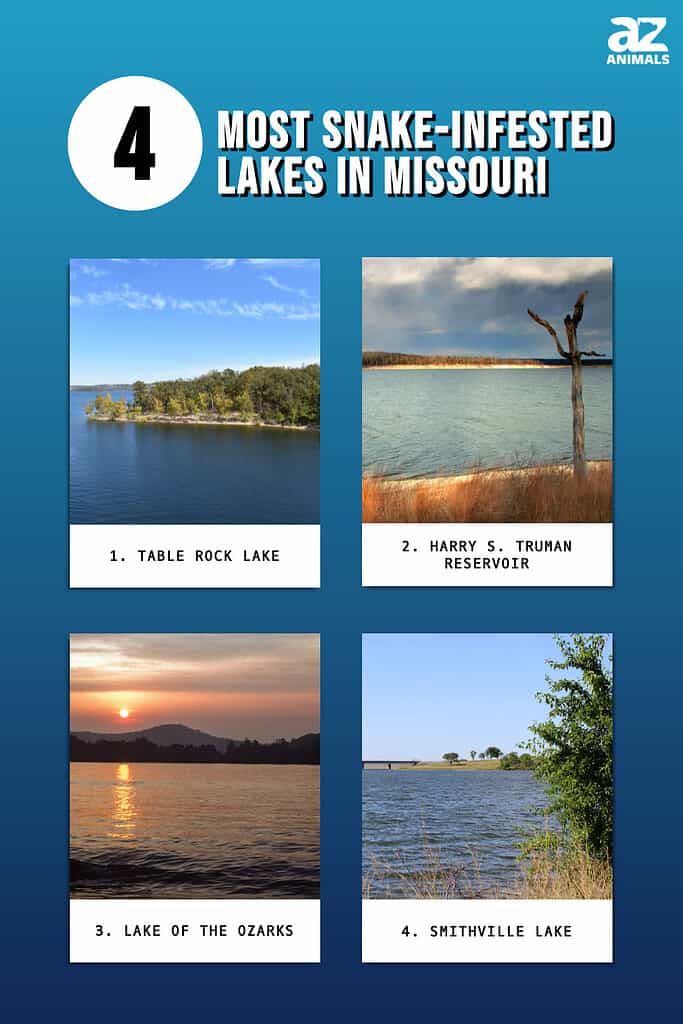
1. Table Rock Lake

Table Rock Lake, Missouri, has lots of prime snake habitats.
©James D. Young/Shutterstock.com
Located just north of the Arkansas border, Table Rock Lake is one of the most snake-infested lakes in Missouri. The Army Corps of Engineers created the lake when they built Table Rock Dam on the White River. At 220 feet, this is the deepest Lake in Missouri.
This lake covers over 40,000 acres with more than 800 miles of shoreline. It’s famous for fishing, boating, camping, and hiking.
You’re most likely to see common water snakes along the shore sunning or in the water. Nearly as common are ring-necked snakes, western rat snakes, and pygmy rattlesnakes.
2. Harry S. Truman Reservoir
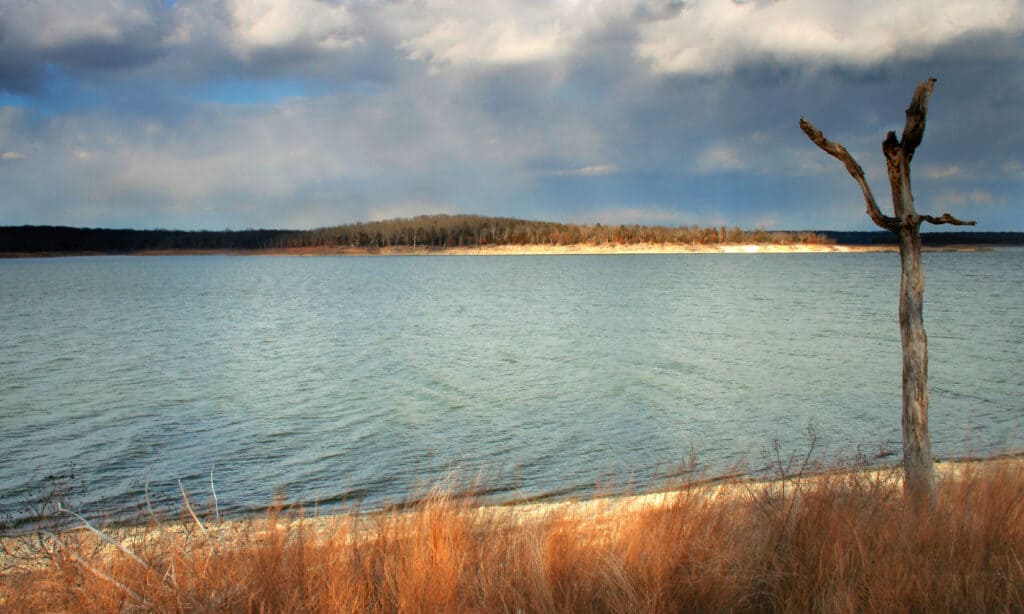
Truman Reservoir, also known as Truman Lake, is located in the state of Missouri, United States.
©iStock.com/StephenFB
A little west of Lake of the Ozarks is Harry S Truman Reservoir. It’s the biggest lake in Missouri by about 400 acres. Harry S. Truman Reservoir covers about 55,409 acres, compared to Lake of the Ozarks’ 55,000.
The Army Corps of Engineers finished Kaysinger Bluff Dam and Reservoir in 1964, primarily for flood control. Then, in 1970, Congress renamed it in honor of the former president, Harry S Truman. Since its creation, the reservoir has become popular for outdoor sports and activities, with hundreds of miles of shoreline.
You’ll likely see western rat snakes around the shoreline and high in the trees, looking for snacks. Another resident often seen sunning themselves on nice rocks and tree branches around the water is the common water snake.
3. Lake of the Ozarks

Lake of the Ozarks is home to over a dozen species of snakes.
©iStock.com/scgerding
This vast lake covers about 55,000 acres and hosts hundreds of species. A popular vacation destination, its expansive shoreline boasts gorgeous birds, fantastic fishing, and many snakes.
Over a dozen species lurk in and around the Lake of the Ozarks. Most are harmless nonvenomous colubrids like common water snakes, western rat snakes, and speckled kingsnakes. Some species, like Dekay’s brownsnake and ring-necked snakes, are so small and secretive that you’ll never see them. However, you could run afoul of the venomous eastern copperhead. But even this dangerous snake wants nothing to do with you.
4. Smithville Lake

Smithville Lake in Missouri is home to many snakes, like Dekay’s brownsnake.
©iStock.com/Jon Kraft
20 Miles north of Kansas City is Smithville Lake, with 7,200 acres and 175 miles of shoreline to explore. Although small compared to the other lakes on our list, Smithville Lake makes up for it with fantastic access to fishing, hiking, mountain bike trails, and lots of space for wildlife. Like snakes. Lots of snakes.
Dekay’s brownsnake is the most common at Smithville Lake, followed by western ratsnakes, common watersnakes, and garter snakes. You may also encounter an eastern copperhead or timber rattlesnake — if you do, be careful and give them space.
Nonvenomous Snakes Around Missouri Lakes
Most of the snakes you’ll encounter around any Missouri lake are harmless. However, it’s important to remember that while they may scare you, they see you as a threat. After all, we outweigh even the biggest North American snake by at least 100 pounds.
Nevertheless, that fact doesn’t mean that they’re any less terrifying if you’re frightened by them. Let’s look at which snakes you’ll find in and around Missouri’s most snake-infested lakes — the good news is that almost all snakes aren’t dangerous to people or pets!
Common Watersnake (Nerodia sipedon)
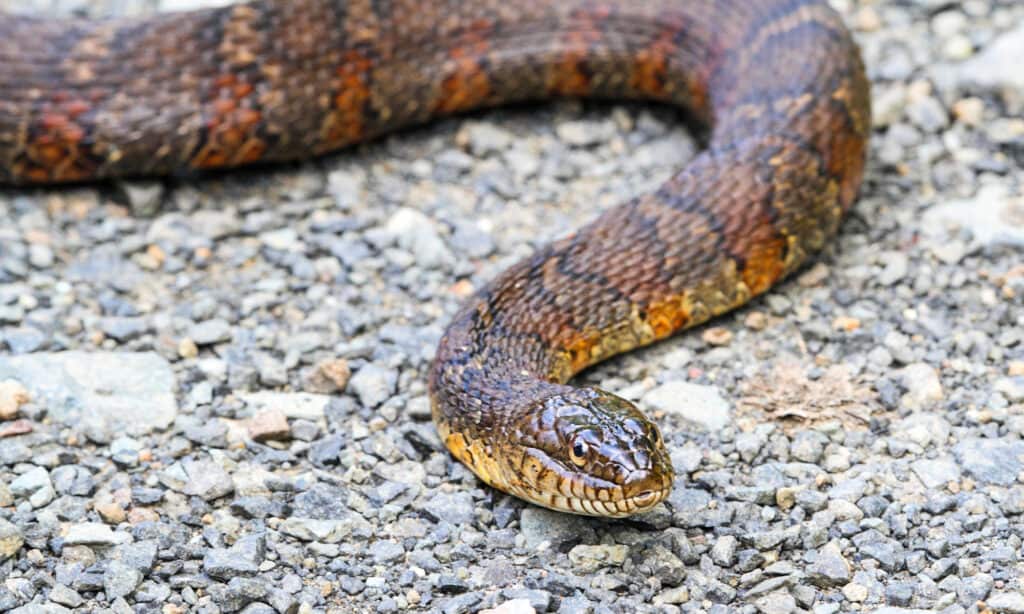
Northern watersnakes are one of the most widespread watersnakes in North America.
©Steve Byland/Shutterstock.com
Also called northern watersnakes, this species is the most widespread of all watersnake species in North America. Like all of the snakes in the Nerodia genus, these snakes are semiaquatic and spend hours in the water daily.
All Missouri lakes have a common watersnake population. You’ll most likely find them along the water’s edge or sunning themselves on a nice warm rock.
They are nonvenomous but have wicked teeth that they use to catch slippery fish and frogs underwater — and defend themselves from any perceived threats.
These snakes average between two and three and a half feet long with thick bodies and keeled scales. As young snakes, they have light base colors that range from gray or reddish to brownish-black. Over the base color are dark cross bands on the neck and blotches down the rest of their bodies. As they age, common watersnakes darken and become harder to see, with some becoming almost black.
Because of their size, coloration, and stout bodies, people often confuse common watersnakes with cottonmouths. However, unlike cottonmouths, these harmless snakes have round pupils and smallish heads with vertical bars around their lips.
Western Rat Snake (Pantherophis obsoletus)
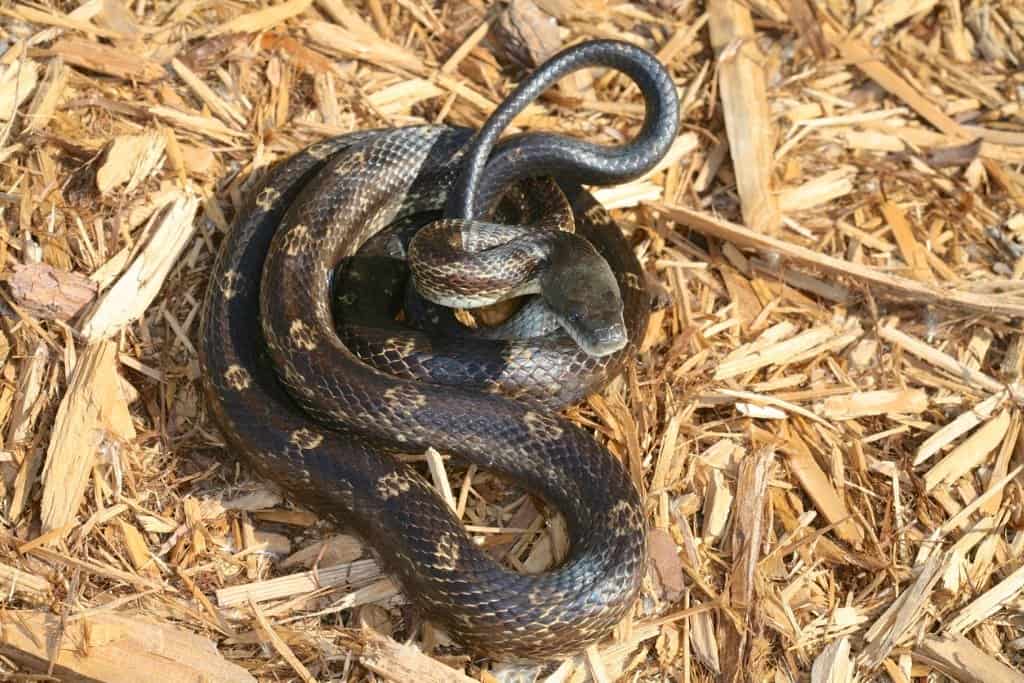
Western rat snakes darken as they mature lose most of the pattern on their heads and bodies.
©iStock.com/Naja Shots
Rat snakes eat any small warm-blooded animal they can overpower. They’re not picky, but their name indicates their favorite food — rodents!
These harmless snakes can grow to six feet long, although the record is a little over eight. As adults, they’re almost solid black with light-colored bellies and chins, so people also call them black snakes. Young western rat snakes are gorgeous and shiny with dark base color and lighter blotches down their backs. Although not thin like racers, rat snakes aren’t chunky like pit vipers. Instead, you could describe them as long and lean.
Western rat snakes have a talent for being in odd places. They’re extraordinary climbers and sometimes climb up vertical walls. One of the most common snakes round Missouri’s lakes, you may find them high up in trees, looking for bird nests. Or, you may see one peaking out from behind the log you’re currently sitting on.
Eastern garter snake (Thamnophis sirtalis sirtalis)

One of the most cold-tolerant snakes in the world, garter snakes are usually active early and later in the year than other species.
©Erik Agar/Shutterstock.com
Smaller and more common than watersnakes, eastern garter snakes are also harmless to people and semiaquatic. They and the watersnakes are part of the Natricinae subfamily of water snakes. These snakes all give live birth in the summer after mating in the spring.
When threatened, they have a “Musk first, don’t bother asking questions ever” policy. Musk is horribly foul-smelling and comes from their cloaca. Unfortunately, there aren’t enough adjectives to describe its foulness.
Although smelly, garter snakes are some of the coolest snakes around. They come in a wide array of colors, but those in Missouri are usually dark black or brownish-black with bright yellow stripes. Eastern garter snakes are long and thin, sometimes four feet long, but most stay smaller. These snakes have small heads and largish eyes with round pupils.
Their main foods are toads, frogs, slugs, and worms. Eastern garter snakes have enlarged rear teeth and what scientists describe as venomous saliva. But it’s so mild that it only affects their prey.
Eastern garter snakes are diurnal and hunt actively through leaf litter, grass, shrubby fields, and along the water’s edge. You will most likely find one when you overturn a log or rock. But be careful if you go out herping; dangerous snakes also hide in those places.
Dekay’s brownsnake (Storeria dekayi)
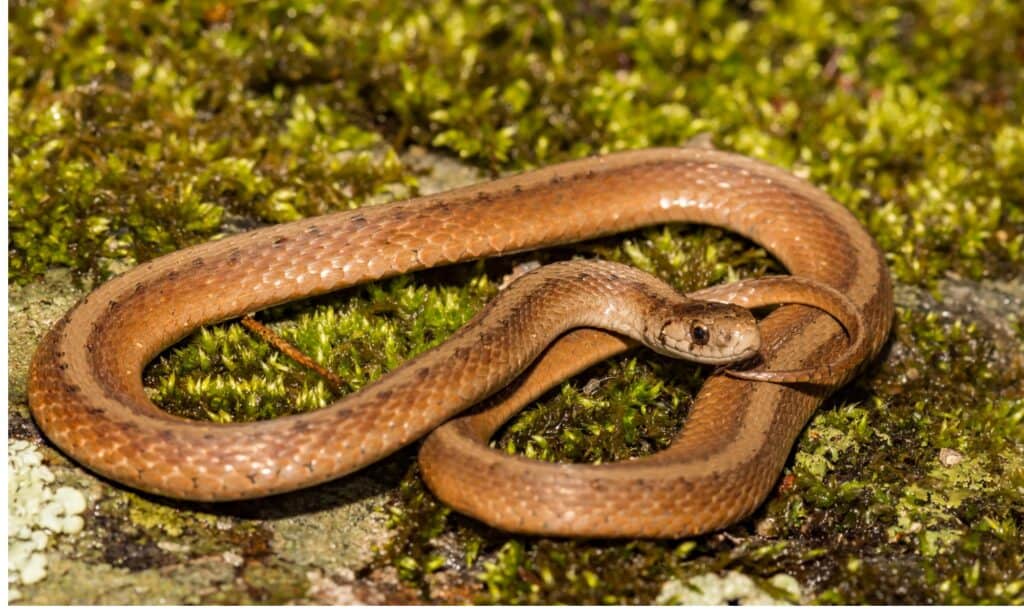
Northern brown snakes are the type species for Storeria dekayi.
©iStock.com/JasonOndreicka
These harmless little snakes only reach about a foot long. In fact, the longest one measured 19 3/8 inches. Dekay’s brownsnakes almost never bite and can’t hurt you.
They’re usually brown with little dark spots along either side of their spine with a lighter stripe down their body. Some have dark markings right behind their heads, but not all.
Unlike many other snakes, Dekay’s brownsnakes thrive around people. They love dark, moist habitats like those around gardens, rivers, and lakes. And this makes sense, given that their diet consists primarily of worms, slugs, and snails.
Dekay’s brownsnakes are one of the most common snakes around Missouri lakes; and great snakes to have around.
Venomous Snakes Around Missouri’s Most Snake-Infested Lakes
Most of the world’s 4,000-plus snakes pose absolutely no danger to people. In North America, the only native snakes that can hurt us are venomous pit vipers and coral snakes.
Fortunately, they aren’t interested in us and only want to be left alone. Still, it’s vital that we know how to identify and avoid them.
Here are the venomous snakes you’re most likely to see around Missouri’s most snake-infested lakes. However, they’re not very common, when you compare the number of sightings on iNaturalist.org against the nonvenomous snake sightings.
Pygmy Rattlesnake: The biggest reported pygmy rattlesnake was 31 inches long. It makes them really hard to spot because their rattles don’t sound the same as bigger species — more like a high-pitched buzzing than a rattle. Pygmy rattlesnakes are more common in southern Missouri; these snakes are very comfortable around Missouri’s lakes. They’re not big swimmers, but you’ll find them in marshes, at the lake’s edge, and on flood plains.
Western Massasauga: This small rattlesnake only occurs in northwestern Missouri. The relative rarity and diminutive size make it hard to spot, even where they’re familiar sights. These snakes often prefer wetter habitats, so that they may be more common around Missouri’s lakes than other pit vipers. They usually stay smaller than three feet.
Eastern Copperhead: One of the most common venomous snakes in the eastern United States also prefers drier forested areas than those found around lakes. They’re not likely to be swimming, although they can. Copperheads’ pattern allows them to blend into the leaf litter seamlessly, which is why so many people get bitten every year — hikers don’t see them and step on the snakes.
Timber Rattlesnake: Their range extends throughout Missouri, but they’re not common. Timber rattlesnakes also prefer forested areas where they can blend in with ground clutter. Although their venom is more dangerous than copperheads, timber rattlesnakes aren’t inclined to bite.
Northern Cottonmouth: Only found in the southern quarter of the state; most sightings are in the southeast. These venomous snakes don’t flee at the first sign of danger — they coil up and show you their fangs. Cottonmouths aren’t as prone to biting as other pit vipers, but a bite will send you to the hospital.
Other Animals Around Missouri Lakes
Missouri’s lakes and rivers make natural homes with everything a wild animal needs to thrive. Home to over 6,000 species, the Show Me State is known for its natural beauty. The Missouri Department of Conservation is a great resource for discovering more about the wildlife you’ll find in the state.
In addition to the snakes you’ll find lurking in and around Missouri lakes, you’ll find more than snakes.
Blanchard’s Cricket Frog
This tiny aquatic tree frog is only half an inch long but makes a lot of noise! You can hear them calling on summer evenings, which is the breeding season for this species. They’re common across much of North America but have become endangered in some areas.
Red Fox
Foxes are social and often travel as a family unit with parents and children.
Red foxes are usually reddish orange with dark legs and bushy tails. There are other color variations, but they’re almost all red in Missouri. They’re more common along the edges of forests and the neighboring open lands. These small canines feed on rodents and other small animals. They help keep rodent populations down, and foxes bury the excess or cover it with leaves and grass when there’s a lot of prey.
Summary Of The 4 Most Snake-Infested Lakes in Missouri
| Rank | Lake | Location |
|---|---|---|
| 1 | Table Rock Lake | near Branson |
| 2 | Harry S. Truman Reservoir | Warsaw |
| 3 | Lake of the Ozarks | Southcentral part of the state, by the city of the same name |
| 4 | Smithville Lake | Kansas City |
The photo featured at the top of this post is © Colton lee garcia/Shutterstock.com
Discover the "Monster" Snake 5X Bigger than an Anaconda
Every day A-Z Animals sends out some of the most incredible facts in the world from our free newsletter. Want to discover the 10 most beautiful snakes in the world, a "snake island" where you're never more than 3 feet from danger, or a "monster" snake 5X larger than an anaconda? Then sign up right now and you'll start receiving our daily newsletter absolutely free.
Thank you for reading! Have some feedback for us? Contact the AZ Animals editorial team.






